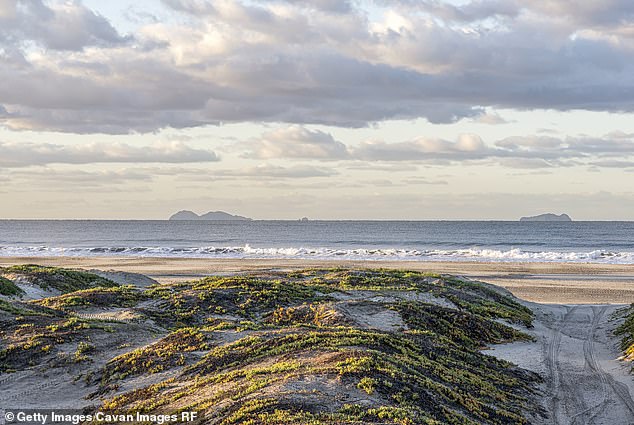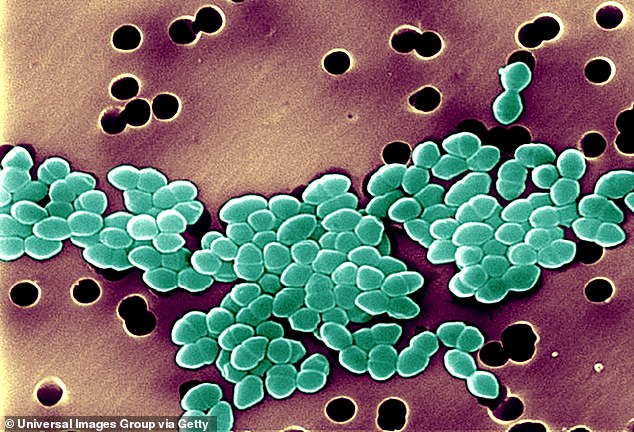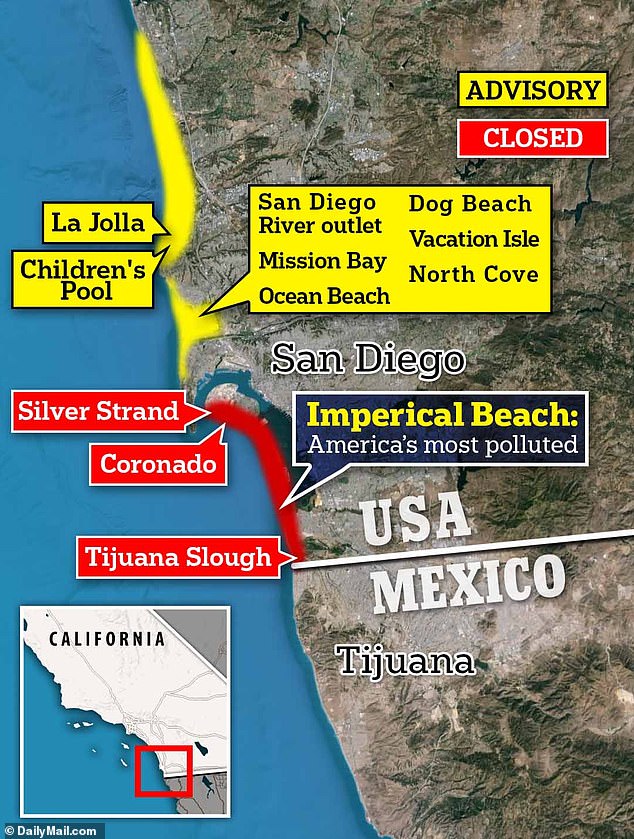Map shows the 100+ US beaches forced to close due to high bacteria levels — as experts reveal the cause
More than 100 beaches in America are closed in the middle of summer because the water is contaminated with deadly bacteria.
Public health officials in California, Michigan and New York have closed beaches due to “high levels” of unspecified bacteria, but Massachusetts called the group or genus of bacteria Enterococci as the main threat to their own beaches.
Enterococci Bacteria are known to cause urinary tract infections, blood infections and endocarditis, an inflammation of the inner lining of the heart that can be fatal if not treated with antibiotics and sometimes surgery.
Experts say the combination of drought and heavy rainfall has overwhelmed municipal sewage systems, sending large amounts of fecal matter into oceans, lakes and rivers.
More than 100 beaches in America are closed at the height of summer because their waters are contaminated with deadly bacteria. One group of those bacteria, Enterococcican cause endocarditis, an inflammation of the heart lining that can be fatal if left untreated
OEnvironmental Protection Agency (EPA) officials said Enterococciwhich typically live in the intestinal tract of warm-blooded animals, including humans, may be ‘an indication of possible contamination of streams and rivers by fecal wastes.’
For this reason, researchers use tests for Enterococci as a means of estimating the raw sewage content of a particular water supply.
This group of bacteria thus serves as a marker that other, toxic, exotic or even unknown new diseases – which also thrive in raw sewage – may likely be present alongside common dangerous bacteria such as Salmonella, E. coliAnd Ciliated cholera animal.
Massachusetts has already had to close at least 37 beaches this summer, including Long Cove on the affluent Martha’s Vineyard archipelago.
And at least one of the summer hotspots in New York’s posh East Hampton village, Havens Beach, has also been closed due to concerns about fecal and bacteria.
Five beaches along Lake Michigan’s recreational areas have been temporarily closed due to “high bacteria levels,” including Port Sanilac State Park on Lake Huron.
Last summer, the New York State Health Department issued guidelines to identify a bacteria commonly found in this raw sewage contamination, Vibrio vulnificusafter infections in the state during beach season killed three people.

At least one summer spot in New York’s elite East Hampton village, Havens Beach, has been closed due to concerns about fecal and bacteria. Above, an aerial view of some Hamptons homes

California has closed at least three beaches in Coronado (pictured) along San Diego Bay in the past week, warning that “bacteria levels exceed health standards”
California has also closed at least three beaches in Coronado along San Diego Bay in the past week, warning that “bacteria levels exceed health standards.”
But while authorities in those states and New York, where more than 63 beaches along Long Island are now closed, did not specify exactly which bacteria they were concerned about, only Massachusetts officials explicitly referred to Enterococci bacteria.
“Without treatment,” said the Cleveland Clinic‘endocarditis can be fatal.’
Health officials attribute the influx of bacteria from sewage to extreme summer weather conditions: Heavy rainfall after long periods of drought can absorb and spread larger amounts of animal and human feces down drains.
These conditions can also lead to sewer flooding as another deluge of rainwater washes untreated sewage out of the sewage treatment plant.

Above is a scanning electron microscope image of an antibiotic-resistant strain of bacteria Enterococciknown to cause urinary tract infections and wound infections

A map showing the 56-mile stretch of beautiful Southern California coastline that has been polluted
Compounding the problem, rising global temperatures due to climate change have caused water temperatures to rise, creating a more hospitable environment for harmful bacteria such as Vibrio vulnificus And Staphylococcus aureusas DailyMail.com reported in June.
To vibratein particular managed to Make 11 people sick in just three states along the East Coast last summer, killing five, and all this during a huge heat wave.
Climate change on Earth has a direct impact on the bacteria’s chances of survival and its ability to infect unsuspecting water sports enthusiasts.
In April, a South Carolina man, Brent Norman, became infected with To vibrate after accidentally stepping on contaminated shells during his daily walk on the beach.
The flesh around his heel began to blister, become red and swollen, which his doctor later confirmed as the cause of the V. vulnificus contact Norman caught from the ocean.
The sheer pain, as he told ABC4 Newswas ‘like someone had hammered a nail through my foot.’
This year, San Diego County officials announced plans to address the long-standing problem of sewage pollution in their own bay area.
Imperial Beach Mayor Paloma Aguirre and San Diego County Supervisor Terra Lawson-Remer have announced plans to seek state and federal funding to fix the century-old sewage problems in San Diego Bay, which have contributed significantly to the recent closure of their Coronado beaches.
“We need our state and federal governments to declare a state of emergency,” Mayor Aguirre said. “Our community deserves clean air and clean water, and we will not rest until this is resolved.”
In the meantime, the The U.S. Centers for Disease Control and Prevention (CDC) recommends that all swimmers and beachgoers stay away from bodies of water, including oceans, lakes and rivers, if the water looks suspicious.
According to the CDC, water that is visibly cloudier than normal, discolored, or smelly is likely contaminated with harmful bacteria.
The government health agency also advised visitors to waterfronts to be aware of pipes that drain into or near the water.
The CDC asks swimmers to stay out of the water if they have diarrhea.
